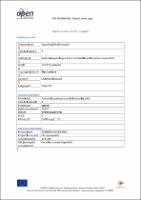Chapter 8 Signalling DNA Damage
Author(s)
Lopez-Contreras, Andres Joaquin
Fernandez-Capetillo, Oscar
Joaquin, Andres
Fernandez-Capetillo, Oscar
Collection
European Research Council (ERC); EU collectionLanguage
EnglishAbstract
During our lifetime, the genome is constantly being exposed to different types of damage caused either by exogenous sources (radiations and/or genotoxic compound) but also as byproducts of endogenous processes (reactive oxigen species during respiration, stalled forks during replication, eroded telomeres, etc). From a structural point of view, there are many types of DNA damage including single or double strand breaks, base modifications and losses or base-pair mismatches. The amount of lesions that we face is enormous with estimates suggesting that each of our 1013 cells has to deal with around 10.000 lesions per day [1]. While the majority of these events are properly resolved by specialized mechanisms, a deficient response to DNA damage, and particularly to DSB, harbors a serious threat to human health [2].
DSB can be formed [1] following an exposure to ionizing radiation (X- or γ-rays) or clastogenic drugs; [2] endogenously, during DNA replication, or [3], as a consequence of reactive oxygen species (ROS) generated during oxidative metabolism. In addition, programmed DSB are used as repair intermediates during V(D)J and Class-Switch recombination (CSR) in lymphocytes [3], or during meiotic recombination [4]. Because of this, immunodeficiency and/or sterility problems are frequently associated with DDR-related pathologies.
Keywords
dna damage; dna damage; Apoptosis; Ataxia telangiectasia and Rad3 related; ATM serine/threonine kinase; DNA repair; DNA-PKcs; Phosphorylation; Protein; UbiquitinDOI
10.5772/50863OCN
1030821210Publisher
InTechOpenPublisher website
https://www.intechopen.com/Publication date and place
2012Grantor
Classification
Science: general issues


 Download
Download